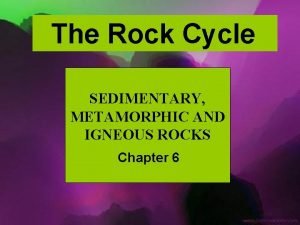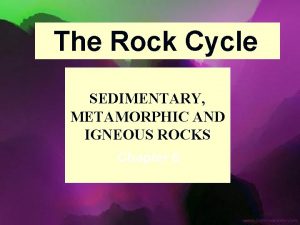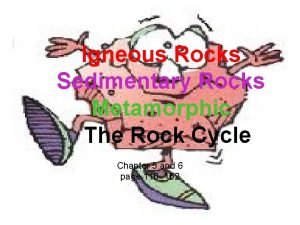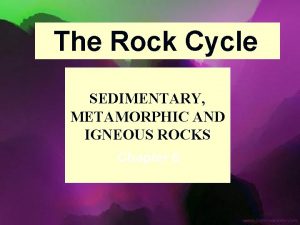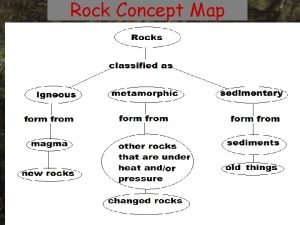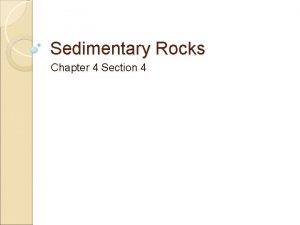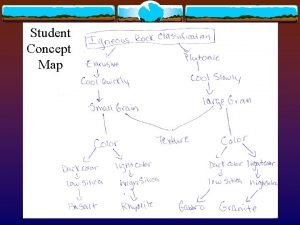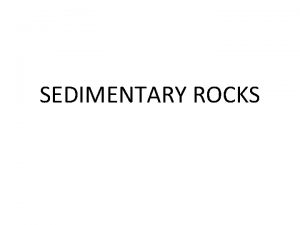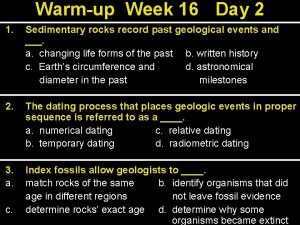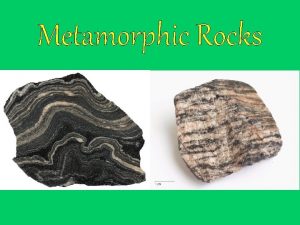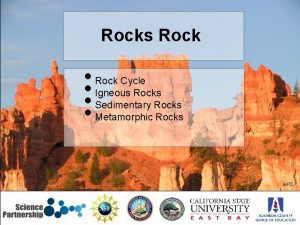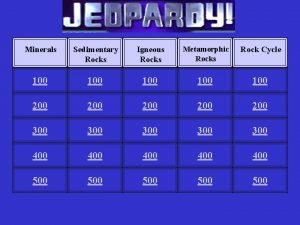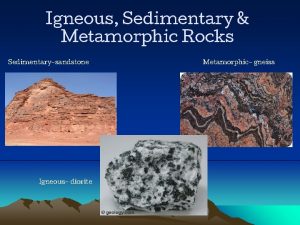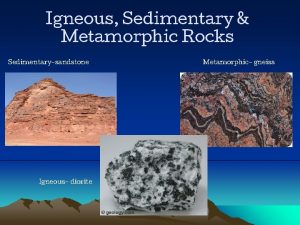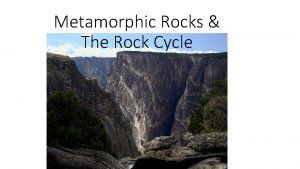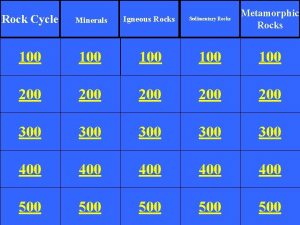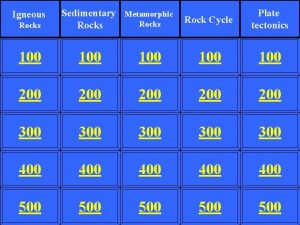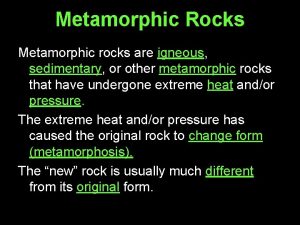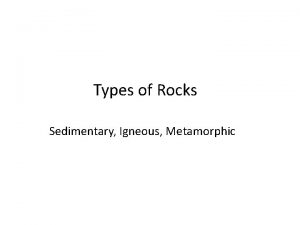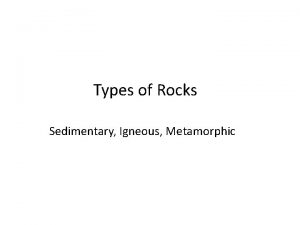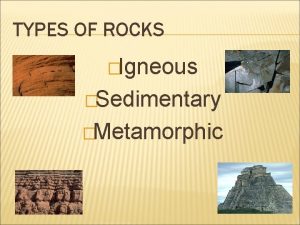The Rock Cycle SEDIMENTARY METAMORPHIC AND IGNEOUS ROCKS



















- Slides: 19

The Rock Cycle SEDIMENTARY, METAMORPHIC AND IGNEOUS ROCKS Chapter 6

What is the Rock Cycle? n 1. 2. 3. The rock cycle is a process in which: A rock forms Changes from one type of rock to another Forms again by processes on and in the Earth.

Three Types of Rock n The three types of rock are: 1. Sedimentary Igneous Metamorphic 2. 3.

Sedimentary Rock is formed by: n n Weathering and Erosion of rocks into smaller pieces or sediment. Deposition Compaction and Cementation Any rock (igneous, sedimentary, or metamorphic) exposed at the Earth's surface can become a sedimentary rock. HOW? ?

Weathering and Erosion Weathering: Breakdown of rock by water, constant heating and cooling or other natural causes, to form sediment. Erosion: Movement of sediment by wind and water

Deposition • Streams and rivers transport sediment to lakes or oceans, or deposit it on nearby floodplains where it accumulates

Compaction and Cementation • Over time these deposited grains and pieces of rock are compacted and cemented together in layers. • The compaction and cementation occurs when sediment is squeezed by the weight of the sediment layers above it. • Each layer may be different from the next layer depending on the type of sediment that is deposited. • Fossils are often found in sedimentary rock.

Sedimentary Rocks Breccia Shale Sandstone

Sedimentary Rock . • The remains of plants and animals become trapped in the layers and over long periods of time and become fossils.

Igneous Rock • Igneous rocks (from the Greek word for fire) form from hot molten rock (magma). • The melt originates deep within the Earth near active plate boundaries or hot spots, then rises toward the surface. • Igneous rocks are divided into two groups, intrusive or extrusive, depending upon where the molten rock solidifies. • Where do you think INtrusive igneous rock forms? Where do you think EXtrusive igneous rock forms?

Extrusive Igneous Rock • Extrusive igneous rock is produced when magma exits and cools outside of, or very near the Earth's surface. • These are the rocks that form at erupting volcanoes • The magma cools and solidifies almost instantly when it is exposed to the cool temperature of the atmosphere. • Cooling time determines rock fromed. • Pumice-cooled quickly • Obsidian-cooled slowly

Black Sand Beach: Hawaii • One of nature's rarest wonders stretches across the island of Hawaii's shores — the black-sand beach of Punalu'u. This magnificent beach formed when lava from two of the world's most active volcanoes, Mauna Loa and Kilauea, spilled into the ocean and quickly cooled, breaking into minuscule pieces that now comprise the "sand. "

Intrusive Igneous Rock • Intrusive, or plutonic igneous rock forms when magma is trapped deep inside the Earth. • Great globs of molten rock rise toward the surface. Some of the magma may feed volcanoes on the Earth's surface, but most remains trapped below, where it cools very slowly over many thousands or millions of years until it solidifies. • Intrusive igneous rock can be pushed to the surface by plate movement. • Granite is a type of intrusive igneous rock.

Metamorphic Rock • Metamorphic rocks are rocks that have "morphed“, or changed into another kind of rock. • These rocks were once igneous or sedimentary rocks. • How do sedimentary and igneous rocks change? • When large pieces of crust collide (convergent boundary, subduction zone), rock is forced downward. • Heat and pressure squeeze the sedimentary or igneous rock and change it into metamorphic rock.

Metamorphic Rock • Shale, a sedimentary rock, is changed by heat and pressure into slate S: shale M: slate • Limestone, a sedimentary rock, is changed by heat and pressure into marble. Marble is used to make statues and countertops. S: Limestone M: Marble

THE ROCK CYCLE The Rock Cycle

Click the flashcards below to study the online flashcards for the rock cycle.

Review • Name the 3 types of rock. • This process causes rock to break down into smaller pieces called sediment. ______________ • This action carries sediments to rivers and lakes. ________ • Sedimentary rock is formed by _________and _______. • Igneous rock is formed from________________. • Two types of igneous rock_______ and _______. • What causes sedimentary and igneous rock to become metamorphic rock? _____and______ • Intrusive igneous rock forms_____________ • Extrusive igneous rock forms_______________ • Can any rock become a sedimentary rock? _________ • Which type of rock would contain fossils? ___________

Rock Cycle Song (Sing to the tune of "Row, Row Your Boat") • http: //www. niehs. nih. gov/kids/lyrics/row. htm • Rock Cycle Song • SEDIMENTARY rock Has been formed in layers Often found near water sources With fossils from decayers • Then there's IGNEOUS rock Here since Earth was born Molten Lava, cooled and hardened That's how it is formed • These two types of rocks Can also be transformed With pressure, heat and chemicals METAMORPHIC they'll become.
 Sedimentary rock song
Sedimentary rock song Igneous rocks metamorphic rocks and sedimentary rocks
Igneous rocks metamorphic rocks and sedimentary rocks Rock cycle definition
Rock cycle definition Metamorphic sedimentary
Metamorphic sedimentary Rock classification concept map
Rock classification concept map Facts about metamorphic rocks
Facts about metamorphic rocks What is the metamorphic rock cycle
What is the metamorphic rock cycle Lutonic
Lutonic Chapter 6 sedimentary and metamorphic rocks
Chapter 6 sedimentary and metamorphic rocks Is coal clastic organic or chemical
Is coal clastic organic or chemical Sedimentary rock description
Sedimentary rock description Sedimentary igneous rocks
Sedimentary igneous rocks Sedimentary rocks turn into metamorphic
Sedimentary rocks turn into metamorphic Sedimentary rocks concept map
Sedimentary rocks concept map Metamorphism
Metamorphism Rock cycle
Rock cycle Igneous rocks
Igneous rocks Metamorphic sedimentary
Metamorphic sedimentary Detrital sedimentary rocks
Detrital sedimentary rocks Sedimentary rocks record past geological events and ____.
Sedimentary rocks record past geological events and ____.
